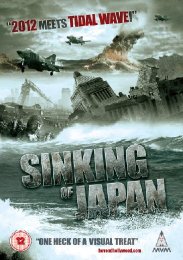Sinking Of Japan
Introduction
I never expected to see a disaster movie made in Japan. Let me rephrase that. I never expected to see a disaster movie made in Japan that didn't have a whopping great lizard in it. I always thought that was the province of Hollywood, incinerate an effects budget so that you could show all manner of havoc on screen, whether they be earthquakes, volcanoes, meteors, aliens, tidal waves or locusts. You have an all star cast freaking out for two hours, reacting to egregious CGI, you have your little guy trying to stay alive, your scientists trying to save the world, and the politicians trying to line their own pockets, and getting a well-deserved death in the middle of the movie. The world will be torn apart, thrown upside down, millions will die, billions will suffer, but it will be alright in the end, because the cute little girl will survive, and so will her pet dog, Binky. Well it turns out that what Hollywood can do, Japan can do also, and just as predictably. Sinking of Japan is their take on the by the numbers disaster flick, with special effects and CGI to rival any Emmerich blockbuster, and to make it even more Hollywood, it's even a remake of a 1973 film of the same name. The difference is that there is no little dog named Binky in this film. With such a radical departure from the stereotype, anything could happen in the next two hours and fifteen minutes.
A devastating earthquake in Suruga province is bad enough, but it's the herald for something far more apocalyptic. A US study has found that the tectonic plate that the Japanese islands ride upon, is due for a megalithic collapse. An almighty hunk of rock is literally pulling the plate down into the mantle, and with it Japan as well. It won't be a gentle farewell either, with volcanic eruptions and earthquakes, tidal waves and disaster marking every pit stop on the way to hell. The US estimates that Japan has just 30 years left to it, but it's Japanese scientist Tadokora who realises that deep crust bacteria are literally causing the crust to delaminate, and the stresses will destroy Japan in just under a year. And while the government dither and argue about what to do, and the world decides that 100 million refugees is a little too much to handle, Tadokora wouldn't be much of a scientist if he didn't come up with a plan. All the while, the earthquakes intensify, and one by one the Japanese islands are destroyed by massive volcanic eruptions. Against this mayhem unfolds the story of three individuals thrown together by circumstance during that first Suruga earthquake. Toshio Onadera is a research sub pilot, who with young orphan Misaki Kuraki was rescued by Reiko Abe, who followed her grandfather into the fire service, and rescues people for a living. She'll be working overtime on this one.
The Disc
You get a 2.35:1 anamorphic transfer for your money, but alas it's an NTSC-PAL standards conversion, so expect a little softness, some judder, and a smidge of ghosting during the dustier or darker scenes. You have the option of DD 5.1 and DD 2.0 Japanese, and while the subtitles are player generated, they are forced as well; you can't turn them off. The surround is the way to go of course, and you get a nice subsonic rumble whenever something big is being destroyed. The dialogue is clear, and there is some appropriate Hollywood-ish music to go with the film, as well as the obligatory power-ballad over the end credits (not by Aerosmith thank God!). Aside from the obvious conversion issues, the film is a little inconsistent, with plenty of green screen work, and variable effects. Some of the destruction scenes are very effective, some less so, and some even a little laughable. There's one shot with a flotilla of drilling ships, that looks like a cut and paste job with Photoshop, while at the other extreme, the orbital shots of Japan being incinerated in a volcanic orgy are very effective indeed.
Conclusion
Somewhere along the way, I fell out of love with the disaster movie. Disaster movies used to be great fun, and mainly because the effects were so bad. The filmmakers had to spend more time on the little people, tell odd stories that happened in the background while the world shook apart. They were really just soap operas with added special effects, and I had hours of fun with films like Earthquake, Meteor, and The Towering Inferno. I can still sit in front of movies like Airport and the original Poseidon Adventure and have a blast. Then some bright spark invented CGI, and the filmmakers could finally show all this stuff for real, expanded over two or more hours, and without those pesky actors and stories taking up valuable 'splosion time. Don't get me wrong, I enjoyed the Emmerich disaster movies as well when I watched them, you can't help but appreciate the effects budgets on films like Independence Day, Godzilla, and Day After Tomorrow, but with that polished CGI gloss has vanished no little heart, and most especially that endearing cheesiness that the earlier disaster epics had. Sinking of Japan is so much like these later Hollywood disaster movies that it's a little eerie.
The story itself is as simple as it gets. The scientists warn of impending doom, the government dithers about it; the scientist gets momentarily sidelined, and then comes up with a plan to save the day. Trials and tribulations later, the day is saved, and the few remaining survivors live happily ever after. Of course a disaster movie would be nothing without the little people, and so we get the perennial survivors Reiko, Toshio and Misaki, thrown together by circumstance, forging a family bond against natural adversity, and generally avoiding giant crushing, exploding, erupting, and drowning death, while all those around them succumb to nature's righteous fury. Then at the end, it will be down to one of the little people to actually save the day, while the politicians wait with their fingers crossed to deliver a triumphant speech. There are one or two differences however. In a Hollywood disaster film, at no point would the heroic scientist actually get angry and violent in a meeting with the government. I've already mentioned the absence of a dog named Binky, Pickles, Bouncer, or anything indicative of a survivor mentality. Also, a Hollywood disaster flick would solve its problem with the liberal application of a nuke. You're not going to see that in a Japanese movie, so our heroic scientist raids Neon Genesis Evangelion's weapon locker and procures some experimental N2 bombs.
It wouldn't be a disaster movie without easily navigable plot-holes. As usual, the N2 bombs have just one detonator, on the entire planet. No spares, no second chances. And for a country in turmoil, with refugees blocking the streets, whole islands disappearing under volcanic lava and ash, the heroic little guy Onadera finds it surprisingly easy to travel where he needs to be. All of these things are typical disaster flick clichés, and really oughtn't to be complained about. If I did have a complaint, it's that this film is over-captioned. Every single event, location, and action gets an accompanying caption. Every volcano that explodes gets named one-by-one, and even if we only briefly visit a location to see it vanish under a tsunami, we still get its name and importance to the plot. I rolled my eyes when we switched to a scene with Reiko at work, training her rescue skills with her fellow firemen. The caption came up, 'abseiling training'. Thanks, I hadn't figured that out for myself. I could also say that I would have preferred more stories of the little people, been able to play the traditional game of who will survive to the end of the film, and who will die in a screaming fireball, and have less time devoted to effects shots, but that's me harking back to the seventies disaster movies again.
If you like disaster movies, especially the modern ones with beaucoup CGI, then you'll love this. Japan shows that anything Hollywood can do, they can do too, and if you are familiar with the works of Emmerich and Michael Bay, then you'll be right at home with this. And for all my whinging and whining and nostalgic look at the films of yesteryear, I did enjoy Sinking of Japan as well, for it hits all the right emotional notes. It makes you care about its characters, and if a disaster movie doesn't do that, then it becomes a box office disaster instead. I have to admit, that it will get the same sort of rewatch frequency from me as The Day After Tomorrow and The Core, which I'm afraid is not a lot. Your mileage may vary though.
































































Your Opinions and Comments
Be the first to post a comment!